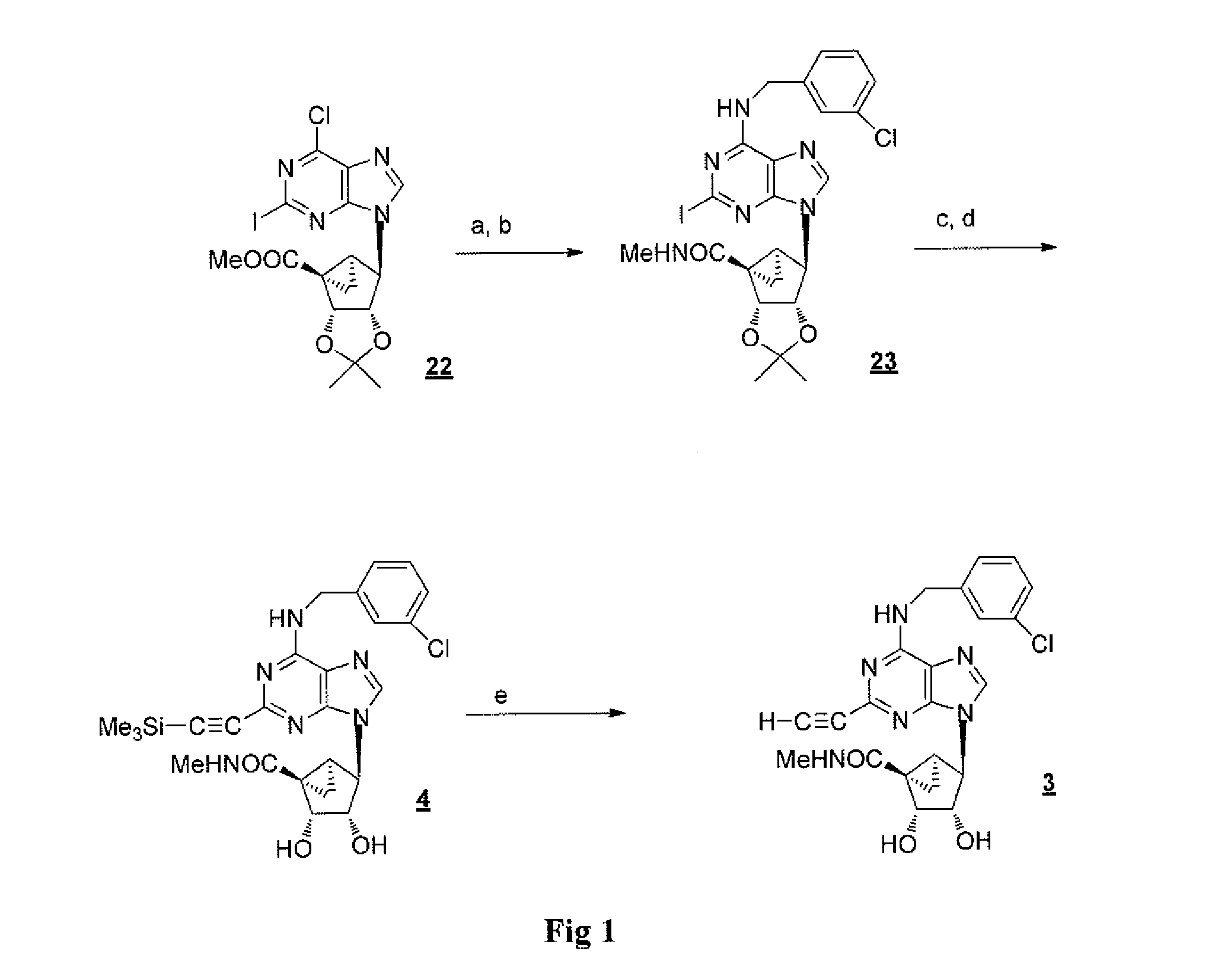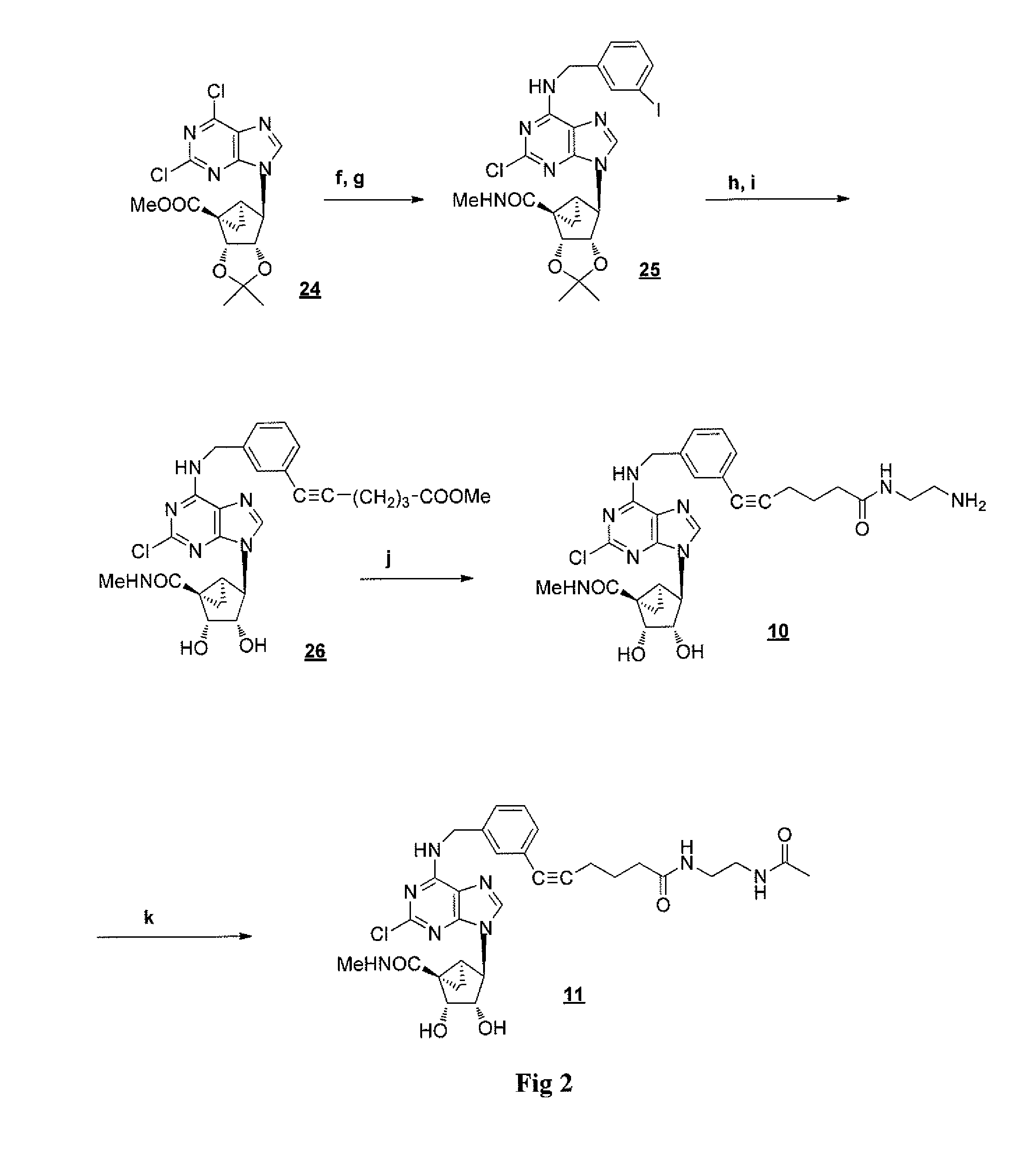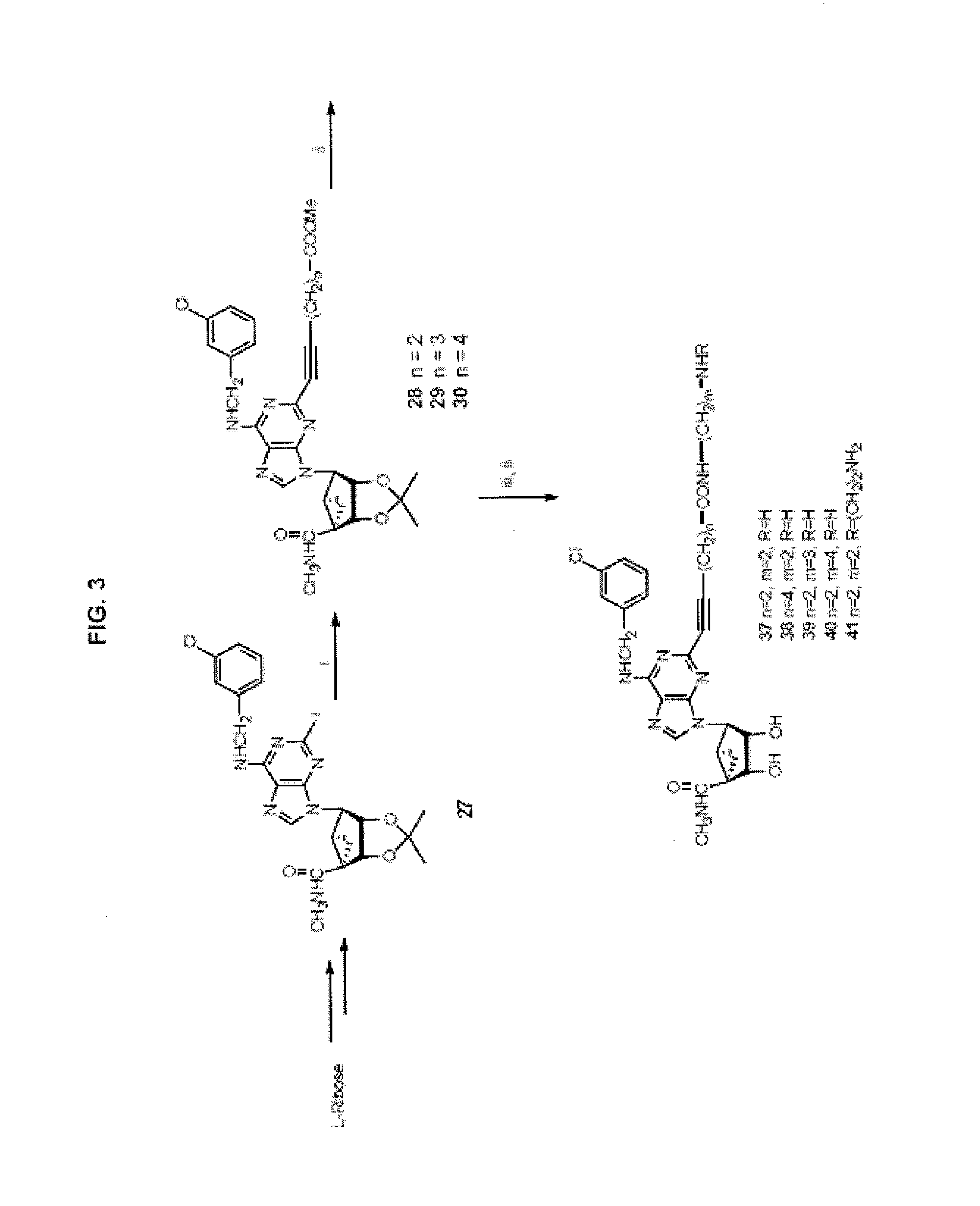A3 adenosine receptor agonists and antagonists
a technology of adenosine receptor and agonist, which is applied in the direction of immunodeficiency, drug composition, biocide, etc., can solve the problems of limited therapeutic application potential utility of asub>1/sub>and asub>2/sub>-selective agents
- Summary
- Abstract
- Description
- Claims
- Application Information
AI Technical Summary
Benefits of technology
Problems solved by technology
Method used
Image
Examples
example 1
[0149]This example illustrates the synthesis of compounds in accordance with an embodiment of the invention.
[0150](1′S,2′R,3′S,4′S,5′S)-4′-[6-Chloro-2-iodo-purin-9-yl]-2′,3′-isopropylidene-bicyclo[3.1.0]hexane-1′-carboxylic acid ethyl ester (22), (1′S,2′R,3′S,4′S,5′S)-4′-[6-(3-Chlorobenzylamino)-2-iodopurin-9-yl]-2′,3′-O-isopropylidene bicyclo[3.1.0]hexane-1′-carboxylic N-methylamide (23), (1′S,2′R,3′S,4′S,5′S)-4′-[2,6-Dichloro-purin-9-yl]-2′,3′-isopropylidene-bicyclo[3.1.0]hexane-F-carboxylic acid methyl ester (24), and (1′S,2′R,3′S,4′S,5′S)-4′-[6-(3-Iodobenzylamino)-2-iodopurin-9-yl]-2′,3′-O-isopropylidene bicyclo[3.1.0]hexane-1′-carboxylic N-methylamide (25) were prepared according to a published method. Tchilibon et al., J. Med. Chem., 2005, 48, 1745-1758.
[0151](1′S,2′R,3′S,4′S,5′S)-4′-[6-(2,5-Dimethoxybenzylamino)-2-iodopurin-9-yl]-2′,3′-dihydroxybicyclo[3.1.0]hexane-1′-carboxylic acid N-methylamide (2). To a solution of compound 22 (49 mg, 0.1 mmol) in dichloromethane (0.1 mL)...
example 2
[0176]This example illustrates some of the biological properties of compounds in accordance with an embodiment of the invention.
[0177][125I]N6-(4-amino-3-iodo-benzyl)adenosine-5′-N-methyluronamide ([125I]I-AB-MEGA; 2000 Ci / mmol), [3H]R-PIA (R—N6-[phenylisopropyl]adenosine, 34 Ci / mmol), [3H]CGS21680 (2-[p-(2-carboxyethyl)phenylethylamino]-5′-N-ethylcarboxamido-adenosine, 47 Ci / mmol) and [3H]cAMP (40 Ci / mmol) were from Amersham Pharmacia Biotech (Buckinghamshire, UK). NECA, CGS21680, CPA, and R-PIA were purchased from Sigma-RBI (St. Louis, Mo.). Other chemicals were from standard commercial sources and of analytical grade.
[0178]CHO cells stably expressing human recombinant ARs were cultured in DMEM and F12 (1:1) supplemented with 10% fetal bovine serum, 100 units / ml penicillin, 100 μg / mL streptomycin, 2 μmol / ml glutamine and 800 μg / ml geneticin. After harvest and homogenization, cells were centrifuged at 500 g for 10 min, and the pellet was re-suspended in 50 mM Tris.HCl buffer (pH 7....
example 3
[0180]This example demonstrates a method of preparing compounds in accordance with an embodiment of the invention. D-ribose was protected with TBDPS-Cl followed by alkaline hydrolysis, thus providing acid 102. Reductive decarboxylation of acid 102 was carried out using non-toxic tris(trimethylsilyl)silane as a hydrogen donor and produced the silyl ether 103 in 40% yield. The silyl ether 103 was deprotected with TBAF. The resultant alcohol 104 was converted into a key dichloropurine derivative 106 through a Mitsonobu reaction (FIG. 4). Derivative 106 reacted with an excess of the corresponding primary amine to give the N6 substituted and 2′,3′-isopropylidene protected derivatives compounds 117a-113a, followed by acid catalyzed deprotection to give the N6-3-halobenzyl and related arylmethyl derivatives 107b-113b.
(1R,2S,3R,4R,5R)-3,4-O-(Isopropylidene)-2-O-(tert-butyldiphenylsilyl)-2,3,4-trihydroxybicyclo[3.1.0]hexane-1-carboxylic acid (102)
[0181]tert-Butyldiphenylsilyl chloride (2.70 ...
PUM
| Property | Measurement | Unit |
|---|---|---|
| flow rate | aaaaa | aaaaa |
| pH | aaaaa | aaaaa |
| temperature | aaaaa | aaaaa |
Abstract
Description
Claims
Application Information
 Login to View More
Login to View More - R&D
- Intellectual Property
- Life Sciences
- Materials
- Tech Scout
- Unparalleled Data Quality
- Higher Quality Content
- 60% Fewer Hallucinations
Browse by: Latest US Patents, China's latest patents, Technical Efficacy Thesaurus, Application Domain, Technology Topic, Popular Technical Reports.
© 2025 PatSnap. All rights reserved.Legal|Privacy policy|Modern Slavery Act Transparency Statement|Sitemap|About US| Contact US: help@patsnap.com



